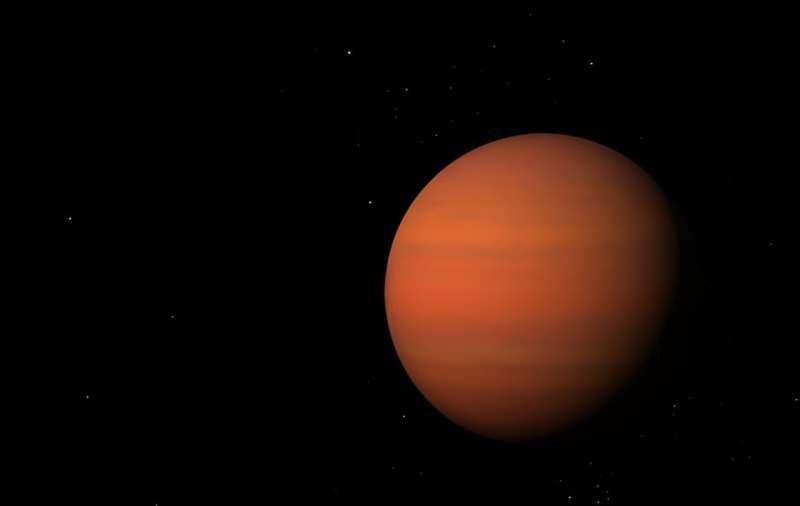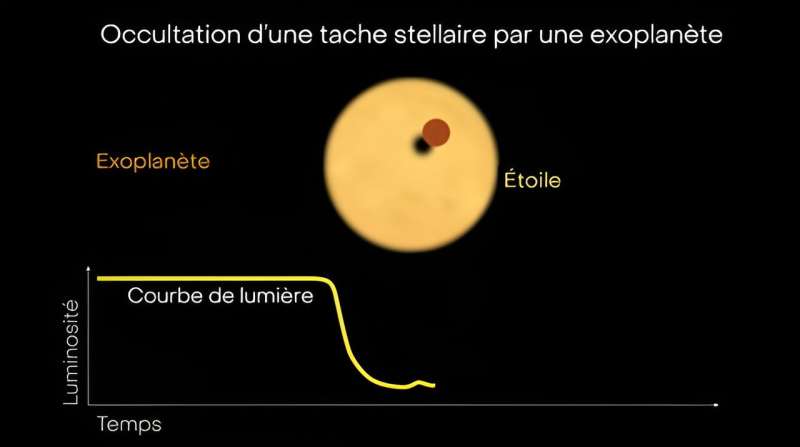This article has been reviewed according to Science X's editorial process and policies. Editors have highlighted the following attributes while ensuring the content's credibility:
fact-checked
peer-reviewed publication
trusted source
proofread
Secrets of a hot Saturn and its spotted star unlocked

A team of astronomers including McGill Professor Nicolas Cowan has unraveled the enigmatic atmosphere of the exoplanet HAT-P-18 b, shedding light on its intriguing blend of gases, clouds, and even the effects of its star's activity
Exoplanets, planets located beyond our solar system, captivate both scientists and the public, holding the promise of unveiling diverse planetary systems and potentially habitable worlds. Despite being very much not like our Earth, large gas giant planets found very close to their stars have proven to be ideal test targets for telescopes like the James Webb Space Telescope (JWST) to refine astronomers' methods of understanding exoplanets.
One such planet is HAT-P-18 b, a "hot Saturn" type planet located over 500 light-years away with a mass similar to Saturn's but a size closer to that of the larger Jupiter. This gives the exoplanet a puffed-up atmosphere that is especially ideal for analysis.
Led by researchers from the Trottier Institute for Research on Exoplanets at McGill University and the Université de Montréal (UdeM), a team of astronomers harnessed the power of the revolutionary Webb Telescope to study HAT-P-18 b. Their findings, detailed in the journal Monthly Notices of the Royal Astronomical Society (MNRAS), provide a comprehensive portrait of the hot Saturn's atmosphere while delving into the complexities of distinguishing atmospheric signals from stellar activity.
"The James Webb Space Telescope provides exoplanet observations so precise that we are limited by our understanding of their host stars. Fortunately, those same data- especially with the made-in-Canada NIRISS instrument- allow us to measure what the star is doing during our observations and correct for it, so we can figure out exactly what is in these planets' atmospheres," said Nicolas Cowan, Professor in McGill University's Department of Earth and Planetary Sciences.
Passing over a spotted star
Observations from the Webb Telescope were taken while the exoplanet HAT-P-18 b passed in front of its sun-like star. This moment is called a transit and is crucial to detect and further characterize an exoplanet from hundreds of light-years away with surprising precision. Astronomers are not observing light emitted directly by the distant planet. Rather, they are studying how the central star's light is blocked and affected by the planet orbiting it.
Exoplanet hunters must thus grapple with the challenge of disentangling signals caused by the presence of the planet and those caused by the star's own properties. Just like our sun, stars do not have uniform surfaces.
They can have dark star spots and bright regions, creating signals that mimic a planet's atmospheric attributes. A recent study of the exoplanet TRAPPIST-1 b and its star TRAPPIST-1 led by UdeM Ph.D. student Olivia Lim witnessed an eruption, or flare, on the star's surface, which affected their observations.
In the case of planet HAT-P-18 b, Webb caught the exoplanet right as it passed over a dark spot on its star, HAT-P-18. This is called a spot-crossing event, and its effect was evident in the data collected for the study. The team also reported the presence of numerous other star spots on HAT-P-18 b's surface, which were not blocked out by the exoplanet.
To accurately determine the exoplanet's atmospheric composition, the researchers determined it was necessary to simultaneously model the planetary atmosphere as well as the star's peculiarities. They state that such consideration will be crucial in treating future exoplanet observations from the JWST to harness their potential fully.

H2O, CO2, and clouds in a scorching atmosphere
Following their careful modeling of both the exoplanet and the star in the HAT-P-18 system, the team of astronomers then performed a meticulous dissection of HAT-P-18 b's atmospheric composition.
By inspecting the light that filters through the exoplanet's atmosphere as it transits its host star, the researchers discerned the presence of water vapor (H2O) and carbon dioxide (CO2). The researchers also detected the possible presence of sodium.
Adding intrigue to the findings, the team observed strong signs of a cloud deck in HAT-P-18 b's atmosphere, which appears to be muting the signals of many of its molecules. They also concluded that the star's surface was covered by many dark spots that can significantly influence the interpretation of the data.
An earlier analysis of the same JWST data led by a team at Johns Hopkins University had also revealed a clear detection of water and CO2, but also reported the detection of small particles at high-altitudes called hazes and found hints of methane (CH4).
The work from the Université de Montréal astronomers, which was the first time the stars' surface characteristics were considered with the planet's atmosphere, revealed a different picture. The CH4 detection was not confirmed, and the water abundance they determined was ten times lower than previously found.
They also found that the previous study's detection of hazes could instead be caused by star spots on the star's surface, highlighting the importance of considering the star in the analysis.
While molecules like water, carbon dioxide, and methane can be interpreted as biosignatures, or signs of life, in certain ratios or in combination with other molecules, HAT-P-18 b's scorching temperatures of close to 600 degrees Celsius do not bode well for the planet's habitability.
The data used from the JWST in this study were collected by the Canadian-made NIRISS (Near-Infrared Imager and Slitless Spectrograph) instrument, which has provided astronomers with the unparalleled ability to differentiate many of HAT-P-18 b's atmospheric characteristics from one another.
The results show that observations taken on the far-visible to near-infrared within the NIRISS instrument's wavelength range are essential to disentangle the signals from the planetary atmosphere and the star. Future observations from another JWST instrument, the Near Infrared Spectrograph (NIRSpec), would help refine the team's results, such as the CO2 detection, and shed even more light on the intricacies of this hot Saturn exoplanet.
More information: Marylou Fournier-Tondreau et al, Near-Infrared Transmission Spectroscopy of HAT-P-18 b with NIRISS: Disentangling Planetary and Stellar Features in the Era of JWST, Monthly Notices of the Royal Astronomical Society (2023). DOI: 10.1093/mnras/stad3813. On arXiv: DOI: 10.48550/arxiv.2310.14950
Journal information: arXiv , Monthly Notices of the Royal Astronomical Society
Provided by McGill University





















